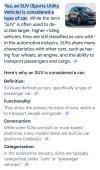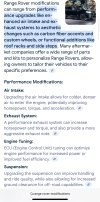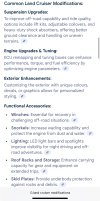It’s taken 436 posts and 22 pages but I think we’ve successfully proven that no one on this forum is helpful and that OP is by far and away a high value individual and we’re all betas.
Now to match his post length with some AI drivel:
Ah, changing the differentials on a Range Rover L322—now there’s a job that can lead you down a rabbit hole of mechanical pondering, tea-drinking procrastination, and more than a few “while I’m in there” moments. It’s one of those tasks that sounds straightforward when you first say it out loud, but once you’re under the vehicle staring at bolts encrusted with the finest blend of British mud and corrosion, you realise it’s anything but simple. The L322, after all, is a heavy old beast with its fair share of quirks, and the diffs play no small role in keeping the whole thing moving gracefully over tarmac, gravel, or a muddy field somewhere in the middle of nowhere.
Let’s start with the why. Why would anyone want to change the differentials on an L322 in the first place? Well, over time, the factory-fitted diffs—whether open, electronic, or limited-slip—can wear out. Bearings start to grumble, pinions develop a bit of lash, and before you know it, you’ve got an ominous whining noise on overrun that makes you start budgeting for a rebuild. Some owners go a step further and swap diffs preemptively, especially if they’re upgrading tyre sizes or moving towards a more off-road-focused setup. Others just want the peace of mind of knowing the thing won’t leave them stranded halfway up a green lane in the pouring rain with a diff that’s decided to let go in spectacular fashion.
Of course, getting the old diff out isn’t as easy as just undoing a few bolts and dropping it onto the floor with a satisfying clang. No, the L322 likes to complicate things a bit. You’ll need to factor in driveshaft removal, potentially dealing with seized bolts, and often a fair amount of careful persuasion to get the diff clear of the subframe and other assorted obstacles. The front and rear diffs are slightly different animals too—the front tends to be a bit fiddlier due to less room to manoeuvre, especially if you’re not inclined to drop the entire front subframe, though some brave souls will tackle it in-situ with enough patience (and perhaps a bit of swearing).
When it comes to replacement options, you’re faced with a whole menu of possibilities. Stick with OEM? Go for a remanufactured unit? Or perhaps upgrade to something beefier like an Ashcroft ATB if you’re planning on tackling more serious terrain? Each option has its pros and cons. Some folks will argue there’s nothing quite like an OEM diff to keep the L322’s driving manners civilised on the road, while others swear by aftermarket upgrades for the extra traction and durability. It really depends on what you use the vehicle for. Daily commuter? Probably stick with stock. Off-road toy or overland rig? Might be worth spending a bit more for an upgrade.
Then there’s the all-important matter of fluids. The L322 isn’t one of those vehicles where you can get away with pouring in any old gear oil and hoping for the best. Land Rover was very particular about diff oils, especially for the electronically controlled locking rear diff if you’ve got one of those fitted. Using the wrong fluid can lead to premature wear or outright failure, which is exactly what you’re trying to avoid in the first place. So it’s worth sourcing the correct specification fluid, even if it means paying a bit extra or ordering from a specialist.
All in all, changing diffs on an L322 is one of those jobs that can be as rewarding as it is time-consuming. It’s not something you’ll want to rush, nor is it the sort of job you’d tackle casually on a Sunday afternoon unless you’ve got plenty of time and a backup vehicle just in case. But for those willing to dive into the job properly, armed with a decent socket set, some mechanical sympathy, and perhaps a workshop manual that’s seen better days, it’s a chance to keep one of Britain’s finest 4x4s running as it should—silently, smoothly, and ready for whatever the road (or lack of it) throws its way.






